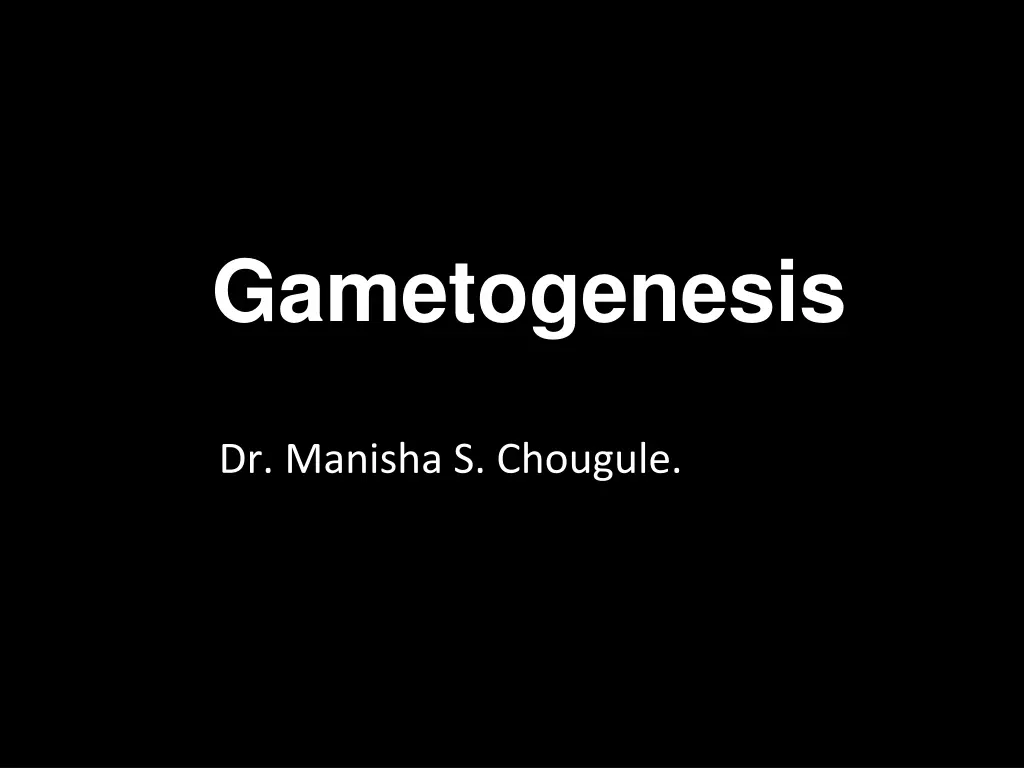
Understanding Gametogenesis: The Formation of Gametes and Spermatozoa
Learn about gametogenesis, the process of gamete formation in males and females. Explore spermatogenesis and oogenesis, detailing the stages from germ cell development to mature sperm and ova. Understand the crucial role of Sertoli cells in supporting spermatogenesis and the transformation of spermatids into spermatozoa through spermiogenesis.
Download Presentation

Please find below an Image/Link to download the presentation.
The content on the website is provided AS IS for your information and personal use only. It may not be sold, licensed, or shared on other websites without obtaining consent from the author. If you encounter any issues during the download, it is possible that the publisher has removed the file from their server.
You are allowed to download the files provided on this website for personal or commercial use, subject to the condition that they are used lawfully. All files are the property of their respective owners.
The content on the website is provided AS IS for your information and personal use only. It may not be sold, licensed, or shared on other websites without obtaining consent from the author.
E N D
Presentation Transcript
Gametogenesis Dr. DDr. Manisha S. Chougule.
Gametogenesis Gametogenesis: formation of gametes. Gametes develop in the gonads (sex cells). In males, it is spermatogenesis, formation of sperm. In females, it is oogenesis, formation of ova.
Spermatogenesis Process by which spermatogonia differentiate into mature spermatozoa. Begins at puberty. Spermatozoa are formed in the wall of seminiferous tubules of the testes.
Stages in Spermatogenesis Many cells of different sizes and shapes: (a) Various cell stages in spermatogenesis (b) Sertoli (sustentacular) cells Sertoli cells provide support and nutrition to germ cells. Regulated hormone (LH). It binds to Leydig cells to stimulate production. by luteinising testosterone
Spermiogenesis Primary spermatocyte The transformation of a circular spermatid to a spermatozoon is called spermiogenesis. process of Meiosis I Secondary spermatocytes Meiosis II Spermatids Spermiogenesis Spermatozoa
Spermatozoon An swimming cell. Consists of a head, neck and a tail (flagellum). Head: ovoid, nucleus. The anterior 2/3rd of nucleus is covered by acrosomal cap. Tail has 3 segments: middle piece, principal piece and end piece. actively motile, free consists of
Oogenesis Occurs in the ovaries and in the oviducts. Starts before birth. Ovary has medulla. Oogonia are present in cortex. Oogonia are produced at a very early stage (before birth) and do not multiply thereafter. cortex &
Oogenesis After Telophase I and II, the cytoplasm is not equally divided. One of the new cells gets the majority and it survives, while the other one, body, gets down. a polar broken
IMPORTANTTERMS Gamete: egg or sperm Gametogenesis: process of formation and development of gametes Oogenesis: production ofeggs Spermatogenesis: production of sperms Spermiogenesis: differentiation of sperm morphology Follicle: where eggs mature in theovary Ovulation: release of egg fromfollicle Polar body: nonfunctional product of meiotic divisions inoogenesis Zygote: Fertilizedegg
REFERENCES 1. Essentials of Anatomy for Dentistry Students,1stEdition. 2. Langman s Medical Embryology,11th Edition. 3. Human Embryology, 5thEdition.
MCQ The supporting cells derived from the surface epithelium of testis is- 1. Spermatogonia 2. Spermatocytes 3. Sertoli cells 4. Leydig cells
MCQ Spermatogenesis starts- 1. Before birth 2. After birth 3. At puberty 4. After puberty
MCQ Oogenesis starts- 1. Before birth 2. After birth 3. At puberty 4. After puberty
MCQ Oogonia undergo mitosis to form- 1. Primary oocyte 2. Secondary oocyte 3. First polar body 4. Second polar body
MCQ The process of spermatogenesis is regulated by- 1.Testosterone 2. Luteinising hormone 3. Follicle-stimulating hormone 4. Testicular fluid






















